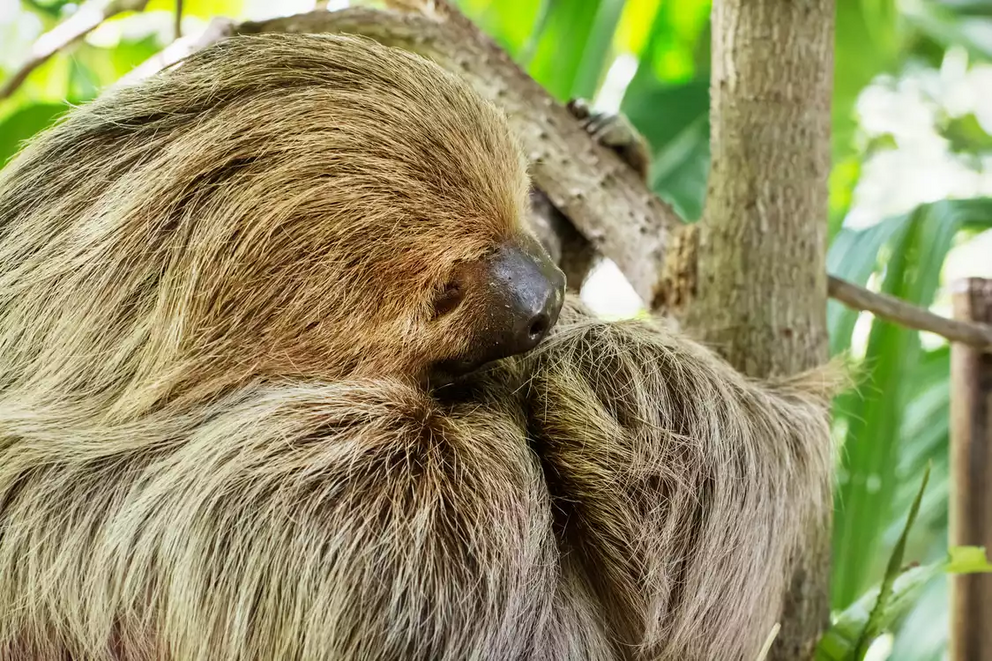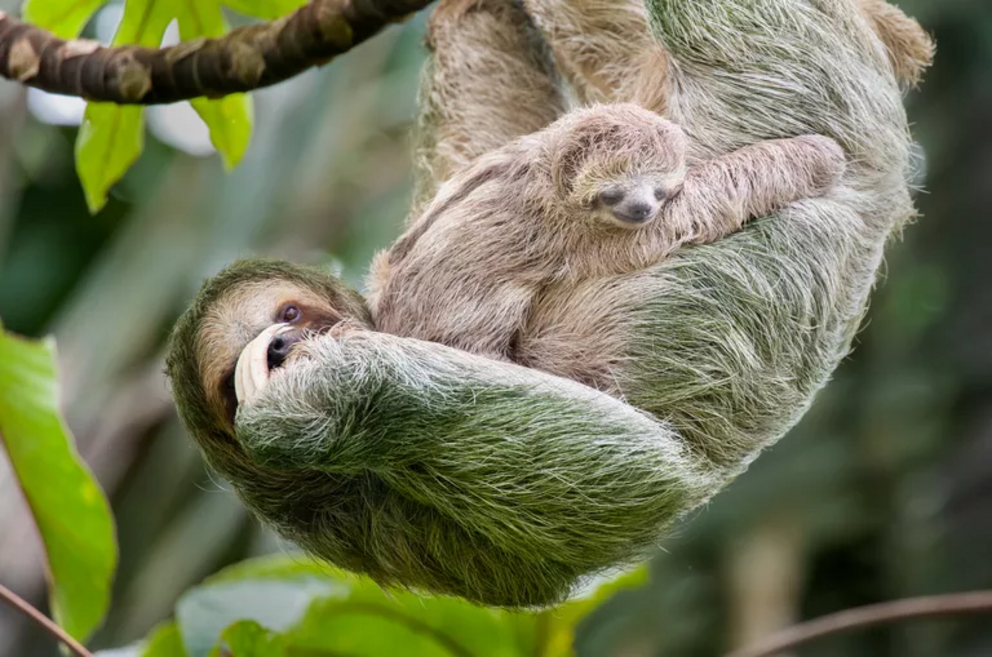Are sloths endangered? Current status of six sloth species
Brown-throated three-toed sloth mother and baby hanging in a treetop, Costa Rica.
Two of the six species of sloths rate high on the list of endangered animals. The pygmy three-toed sloth is "Critically Endangered" and the maned three-toed sloth is considered "Vulnerable."
Pygmy sloths only live in Escudo de Veraguas Island in Panama, and as of the last official IUCN assessment in 2013, there are believed to be less than a 100 pygmy sloths left in the world. The population of the maned sloth, which is mostly native to Brazil, is slowly decreasing. The other four species, while currently considered of "Least Concern," still face threats and population decline.
 Maned three-toed sloth (Bradypus torquatus).
Maned three-toed sloth (Bradypus torquatus).
These odd creatures, recognized for their unhurried pace, are dwindling in numbers. Adult sloths weigh anywhere between 9 and 17 pounds and on average stand about 3 feet high, but specific measurements depend on the species.
They mostly live alone in shrubby vegetation like mangroves and are capable swimmers. They spend most of their time up in trees munching on leaves or sleeping. Their metabolism is incredibly slow and it can take days for them to digest small quantities of food. Divided into two- and three-toed designations, they are fascinating animals worth learning about.
Sloth Species and Conservation Status:
- Pygmy three-toed sloth (Bradypus pygmaeus) - Critically Endangered
- Maned three-toed sloth (Bradypus torquatus) - Vulnerable
- Pale-throated three-toed sloth (Bradypus tridactylus) - Least Concern
- Brown-throated sloth (Bradypus variegatus) - Least Concern
- Linnaeus's two-toed sloth (Choloepus didactylus) - Least Concern
- Hoffman's two-toed sloth (Choloepus hoffmanni) - Least Concern
Threats
Due to habitat destruction and poaching, sloths are highly vulnerable to what goes on in their environments. Though they do have sharp claws and are quite strong, once they come down from the safety of trees, they are exposed to predators and human intrusion. Their fur provides them with camouflage to keep them hidden, but they are much too slow to escape the dangers around them. After humans, their biggest enemies are predatory birds, snakes, and large cats.
 Hoffmann's two-toed sloth (Choloepus hoffmanni).
Hoffmann's two-toed sloth (Choloepus hoffmanni).
Habitat Loss
Deforestation and human population growth is responsible for sloth habitat loss. Since sloths primarily live in the lush, verdant rainforests of Central and South America, keeping their environment intact is crucial for their survival. They depend on trees as the main staples of their diet as well as shelter. However, construction and a need for crop and pasture land has led to large swaths of rainforest deforestation. Sloths rarely come down from the safety of their tree canopies, so without the woodlands, they have no real means of protection.
Poaching
Sloths can live for 20 years in the wild if free from the perils of hunters and predators. Due mostly to the pet trade, sloths are often hunted illegally. Since sloths are one of the slowest animals in the world, this makes it hard for them to escape quickly from humans encroaching on their territory. The reason for their sluggishness is a very low metabolic rate, which is also why sloths travel less than 40 yards on an average day. While sloth meat isn't widely popular, they are sometimes hunted as food, but they are mostly hunted by poachers to trade and sell as pets.
What We Can Do
 Pale-throated three-toed sloth (Bradypus tridactylus).
Pale-throated three-toed sloth (Bradypus tridactylus).
There are several ways to help collectively as well as on an individual level right from your own home. Here are a few options you can consider that will bring positive, impactful assistance to this endangered species.
Donate
Donations to a reputable foundation or organization can help sloth protection projects, research, and educational programs. For example, you can symbolically adopt a sloth as part of the WWF's fund-raising efforts. WWF projects seek to work with local stakeholders to encourage sustainable forestry in sloth habitats. Organizations such as The Sloth Conservation and the Rainforest Alliance also have initiatives to help protect this noble animal.
Since loss of habitat is the most significant threat faced by sloths, donating to organizations dedicated to rainforest conservation can also aid sloth populations. Reputable groups include Amazon Watch, the Rainforest Action Network, and the Rainforest Trust.
Volunteer
Sloths live in remote, tropical areas, so volunteering your time requires a bit of creativity. Traveling to sloth habitats and seeking local groups for in-person volunteer opportunities may be complicated for most people, but these organizations can use your help remotely with fundraising, education, and other administrative tasks. The Sloth Conservation Foundation is one such organization.
When researching volunteer opportunities, be sure to look into the group's work, reputation, and financial accountability. And if your time and resources allow, you can also try volunteering through experiential tourism.
 Linnaeus's two-toed sloth (Choloepus didactylus).
Linnaeus's two-toed sloth (Choloepus didactylus).
Make Green Choices
Above all, the decisions you make at home and in your own day-to-day life are going to have the most impact on the well-being of sloths and animals all over the planet. Even the smallest changes to your routine, buying choices, cleaning supplies, food, and beauty products, can be beneficial. For example, palm oil is one of the number one causes of rainforest destruction in Central and South America. Choosing to buy palm oil products certified by the Rainforest Alliance guarantees that deforestation has not occurred to produce the oil.
Lowering your carbon footprint, reducing waste, and opting for green products are all ways that will have long-term positive effects on restoring healthy wildlife populations.

